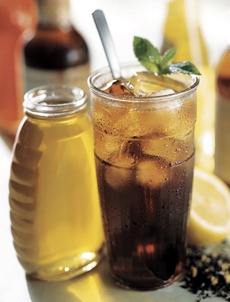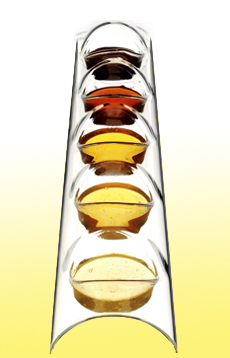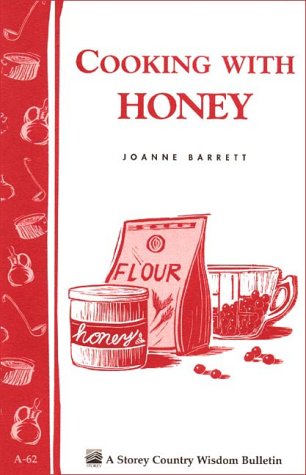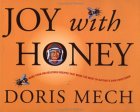

It’s easier to sweeten cold drinks with honey: Sugar often is difficult to dissolve. Photo courtesy National Honey Board.
February 2005
Last Updated October 2012
|
 |
Honey Types
Page 4: Popular Honey Varietals
This is Page 4 of a four-page article. Click on the black links below to visit other pages.
Honey Varietals: Overview(Monofloral Honey)
Not all flowers have nectar that makes good honey; and bees other than honeybees make honey for food. but there are many hundreds of honey varietals. The flavor and color of honey are determined by the nectar source. The U.S. produced 171.7 million pounds of honey from 26 million bee colonies in 2003—from clear-as-water to dark brown, from very mild to very strong flavored, from delicately perfumed to pungent. (NOTE: New Zealand and Australian specialty honeys are included in this chart because they are now arriving in U.S. specialty food venues. Look for them.)
Crystallization depends on the proportion of fructose to glucose in the honey (each varietal has its own proportion); the higher the fructose, the less likely to crystallize.
|
As with wine, the flavor and color of honey can differ every year, even from the same location and beekeeper. While the same type of flower from a different region can produce a different region, even locally, as with grapes, a difference in the weather and “blossoming season” will make a difference in the honey.
Finally, it’s important to note that while some honeys taste exactly like their source—buckwheat honey tastes exactly like buckwheat—a honey does not necessarily taste like the fruit of the plant. Blueberry honey does not necessarily taste like blueberries, nor raspberry honey like raspberries, etc. Honeys are based on the nectar of the flower, not on the infusion of the fruit of the plant. Sometimes there’s a close correlation, sometimes not. Some fruit honeys are enhanced with extra flavor; read the labels carefully. Raw honey means that nothing has been added. “Milky” is the classic honey flavor.
|
|

Different plants produce different flavors and colors of honey. Colors range from clear to black-brown. Photo courtesy National Honey Board. |
Honey Varietals: Overview(Monofloral Honey)
There are hundreds of varietals in the U.S. alone. This list aims to feature those most frequently found at retail.
| Honey Varietal |
Flavor |
Color |
| Acacia (Black locust tree) |
Mild, slightly tangy, floral, doesn’t crystallize |
Water white to pale amber |
| Alfalfa (generally blended) |
Nearly flavorless to milky, some has spicy notes |
White |
| Apple Blossom |
A hint of apple in the aroma |
Light to medium amber |
| Aster |
Flavor depends on region and species of aster; crystallizes quickly |
White to light amber |
| Avocado |
Fairly strong, buttery flavor |
Dark amber |
| Basswood |
Strong, zesty (becomes minty when mixed with a mild honey) |
Dark amber |
| Blackberry |
Delicate and sweet with a hint of fruit |
Very light amber |
| Black Button Sage |
Slightly herbaceous, slow to crystallize |
Medium amber |
| Black Locust |
Fruity, rare (the trees blossom only every few years) |
Pale to dark amber |
| Blueberry |
Fruity, blueberry aftertaste |
Medium amber |
| Buckwheat |
Strong buckwheat, malty flavor |
Dark brown |
| Blue Curl |
N/A |
N/A |
| Canola |
Delicate, low acid, crystallizes easily |
Light amber to white |
| Chestnut |
Strong, nutty, spicy, a bitter aftertaste (perfect with gorgonzola and parmesan) |
Dark brown |
| Clover |
Tangy and delicate; most labeled “clover” are actually blended; crystallizes easily |
Water white to amber |
| Cranberry |
Mild fruity flavor with tart aftertaste |
Medium amber |
| Eucalyptus —Yellow Box, Blue Gum, Red River Gum (U.S. & Australia) |
Mildly sweet, fruity aftertaste; some varieties have a slight menthol flavor |
Dark |
| Fireweed |
Mild, fruity, buttery |
Light to medium amber |
| Gallberry |
Tart wildflower flavor |
Dark amber |
| Goldenrod |
Robust flavor of wildflower and beeswax |
Light amber |
| Heather (Scotland) |
Slightly bitter with an aftertaste of burnt caramel |
Dark amber |
| Huckleberry |
Full-bodied |
Dark amber |
| Kamahi (New Zealand) |
Full-bodied, complex |
Light amber |
| Lavender |
Lavender floral |
Medium amber |
| Leatherwood (Tasmania) |
Strong and spicy |
Dark amber |
| Linden |
Spicy |
Pale amber |
| Lehua |
Buttery with lily-like overtones |
Crystallizes quickly and is made into a light golden cremed honey |
| Mint/Spearmint |
N/A |
N/A |
| Nodding Thistle (New Zealand) |
Delicate floral |
Light amber |
| Orange Blossom |
Hints of citrus-orange and orange blossom |
Light amber to dark amber |
| Pine Honey (Turkey) |
Molasses |
Dark amber |
| Poplar (Tulip Poplar) |
Strong |
Medium amber |
| Pumpkin |
Light with a hint of pumpkin flavor |
Medium amber |
| Purple Sage |
Mild flavor, slow to crystallize |
Water white |
| Rata (New Zealand) |
Mild, rich, almost salty |
White |
| Raspberry |
Will have a mild hint of raspberries; crystallizes as soon as it leaves the comb so is always sold in cremed form |
Cremed light |
| Rewarewa (New Zealand) |
Rich, malty |
Burnished amber |
| Rosemary |
Fragrant and herbaceous; great with cheese |
Pale amber |
| Safflower |
Milky flavor |
Amber to dark amber with a slight greenish cast |
| Sage |
Herbal notes |
Medium amber |
| Saw Palmetto |
Citrusy and herbal with woody overtones |
Medium amber |
| Silkweed |
Strong scent and flavor, spicy condiment honey |
Dark amber |
| Snowberry |
Butterscotch |
N/A |
| Sourwood |
Spicy ginger |
Medium amber |
| Sunflower |
Distinctive floral aroma; crystallizes easily |
Light to medium amber |
| Tawari |
Butterscotch |
Light amber |
| Thyme |
Herbal notes |
Burnt grass |
| Tupelo |
Medium, complex; slow to crystallize |
Golden amber with a slight greenish cast |
| Ulmo (Chile) |
Anise and violet |
N/A |
| Viper’s Bugloss (Borage) (New Zealand) |
Delicate flavor, floral bouquet |
Light amber |
| Wildflower |
Depending on flowers, can be medium-strong and tangy |
Medium amber |
| White Sage |
Clover-like flavor, elegant floral aftertaste |
Translucent yellow |
| |
|
|
Numerous other varietals are available. See HoneyLocator.com.
Some definitions courtesy of Wikipedia and the National Honey Board. The National Honey Board enhances the ability of U.S. honey producers to compete efficiently and effectively in the marketplace and to promote honey and honey products to the consumer.
Go To Page 1: Honey Overview
Go To Article Index Above
Books About Honey
 |
 |
 |
| Cooking With Honey: Hands-on practical advise for cooking with honey. Click here for more information. |
Joy With Honey: 236 delightfully honey packed time tested recipes. Click here for more information. |
Covered in Honey: Discover the bounty of flavors with varietal honey. Click here for more information. |
Honey definitions ® © National Honey Board. Additional material © Copyright Lifestyle Direct, Inc. Images are copyright of their respective owners. |








